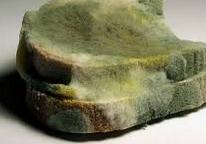To delve into the meaning of the term mold, it is necessary, first of all, to establish its etymological origin. In this case, it must be emphasized that it derives from Latin, specifically from "mufa" or "muffa", which can be translated precisely as "mold."
Various types of fungi are called mold . These are small species that reside in organic environments with a high level of nutrients.
Among the words that can function as synonyms for mold, we can highlight some such as rust, verdigris, mold, verdigris and even verdigris.
 Mold generally develops in humid environments and high temperatures . It has a mycelium with branched filaments, reproducing and propagating through spores .
Mold generally develops in humid environments and high temperatures . It has a mycelium with branched filaments, reproducing and propagating through spores .
It is possible to find mold indoors or outdoors. In the first case, it is common for them to appear in the bathroom or in an environment with high humidity . In nature, they usually grow in shady places where there are decaying plants.
There are homes in which, due to the existence of humidity or lack of ventilation and even because there is no natural light, mold appears on the walls. In that case, it is considered that measures must be taken to put an end to it.
Specifically, to prevent it from appearing on the walls, it is necessary to ventilate adequately, check that there is no water leak and even install dehumidifiers if necessary.
Once the mold has appeared, you must proceed to clean the walls with bleach, use specific products for that situation or use a tool called a pressure washer.
It is important to put a stop to the situation as soon as possible because it can lead to health problems such as skin allergies, asthma and even respiratory allergies, for example.
In the same way, we cannot ignore that mold can also appear on clothes found in a closet. This may be because there is humidity in the environment, because it is not adequately ventilated, or because there is a clear lack of hygiene.
There are many varieties of molds. Some generate highly toxic mycotoxins , although most do not cause serious problems to humans . In any case, when exposed to mold, a person can suffer eye irritation, nasal congestion or respiratory disorders.
It is important to mention that there are molds that are used for cheese making. Perhaps the most famous case is that of blue cheeses (such as Roquefort ), which use molds of the Penicillium genus to achieve their distinctive characteristics. Brie cheese also includes a layer of mold that can be ingested without problems.
According to the dictionary of the Royal Spanish Academy ( RAE ), the idea of mold can also be used to name the modification of organic matter when it is covered by certain types of vegetation and the sheet that certain chemical changes produce in a metallic body.
In Peru , finally, Moho is a province of the department of Puno that rises next to the northeastern shore of Lake Titicaca . Its capital is a city of the same name.
